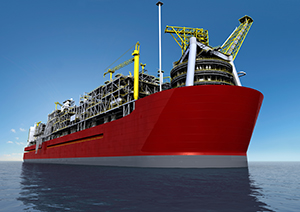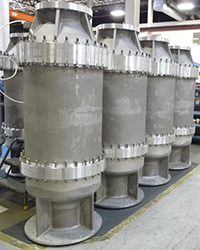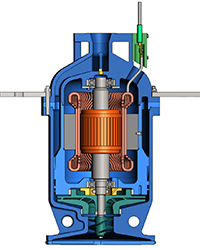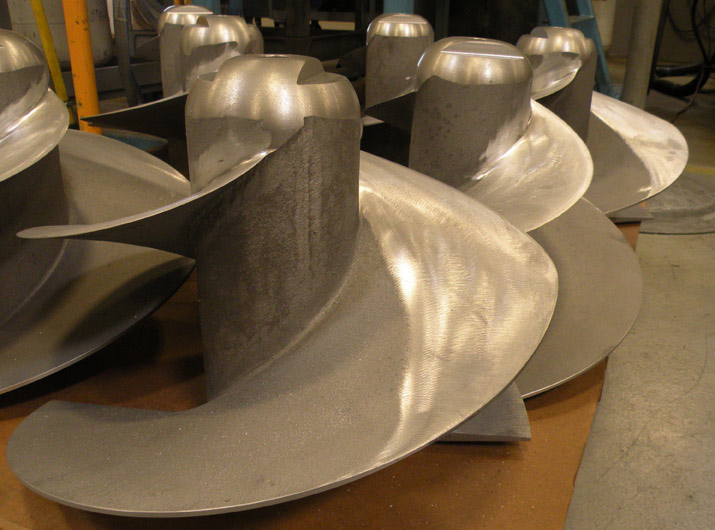Cryogenic Pumps
Cryogenic pumps in various configurations for a wide variety of marine, land-based, floating, and small-scale applications.
Ebara Elliott Energy submersible, electric cryogenic pumps incorporate the safest designs for rotating equipment in the industry. The motor is submerged in the oxygen-free cryogenic liquid, removing the potential for ignition, and minimizing the amount of electrical components that are installed within the hazardous area. Additionally, there is no need for rotating seals, eliminating a source for leaks. This allows the design to safely accommodate caustic chemicals such as ammonia or methane. Moreover, rotating components are contained within casings that are submerged within a secondary tank or vessel, further protecting personnel from potential hazards.
Cryodynamics® equipment is designed to operate in liquefied gases with temperatures ranging from ambient (warm) to cryogenic. The submerged motor operates in a non-conductive liquefied gas.
Our cryogenic pumps are available in a number of configurations for a wide variety of land-based, marine, floating, and small-scale applications.
Cryodynamics® equipment is designed to operate in liquefied gases with temperatures ranging from ambient (warm) to cryogenic. The submerged motor operates in a non-conductive liquefied gas.
Our cryogenic pumps are available in a number of configurations for a wide variety of land-based, marine, floating, and small-scale applications.
In-Tank (Retractable) Pump
The submerged pump and motor unit is designed to fit into the smallest practical column diameter by using an axial diffuser design. The column acts as a guide to seat the pump during installation and also performs as the discharge pipe from the pump to the top of the tank. Each pump is fitted with an inducer, which is an axial flow impeller located at the lowest possible level of the tank to improve the net positive suction head required (NPSHR), allowing operators to lower tank liquid levels extremely low. To isolate the tank contents from the pump column, a suction valve which incorporates a dual pressure sensitive seal is used. The suction valve is flanged to the lower end of the pump column and is closed by coil springs as well as by the hydrostatic pressure of the liquid in the tank.
To open the valve, the inlet feet of the pump press down against the bottom plate during insertion, forcing it to open using just the weight of the pump. It can be closed at any time by simply hoisting the lifting eye located at the top of the column without disassembly of any other components. Once the valve is closed, the column can be inerted with nitrogen gas to allow the safe removal of the pump even with liquid in the tank. The power cables used in the retraction system are a high-quality armored cable. These cables are Underwriter’s Laboratory (UL) listed and were developed specifically for use in cryogenic liquids. The lifting cables used are an anti-twist, stainless steel cable that can provide many years of use without replacement.
Suction Vessel Mounted Pump
The pump and motor assembly of the suction vessel mounted pump is contained within a suction vessel built to the appropriate pressure vessel code for each application, making the installation safe, simple, and reliable. The suction vessel functions as the outer pump casing. It is fabricated with a suction nozzle, welded couplings (for drain and liquid level indication), support brackets, a head plate with discharge nozzle, a conduit for electrical cables, and a vent nozzle. The result is a compact, lightweight, uncomplicated installation having low noise levels and significant safety advantages over conventional pumps.
Frequently used as a multi-stage design for vaporizer feed service, the ECC model is also widely used as a single-stage transfer pump. Flow capacities are available up to 3000 m3/h and differential heads up to more than 2,500 meters (depending on flow and power). For multi-stage pumps traditionally used for vaporizer send-out applications, Cryodynamics Products has developed a radial, stiff shaft design to provide a more compact, more reliable machine. By combining the use of radial diffusers, which allows a much shorter stage length, with a much larger shaft diameter, the rotor becomes much more stable, normally operating well below the first critical speed. This new design has proven to be extremely reliable in send-out systems that require a large, multi-stage pump to perform on a continuous, 24-hour-per-day basis.
Frequently used as a multi-stage design for vaporizer feed service, the ECC model is also widely used as a single-stage transfer pump. Flow capacities are available up to 3000 m3/h and differential heads up to more than 2,500 meters (depending on flow and power). For multi-stage pumps traditionally used for vaporizer send-out applications, Cryodynamics Products has developed a radial, stiff shaft design to provide a more compact, more reliable machine. By combining the use of radial diffusers, which allows a much shorter stage length, with a much larger shaft diameter, the rotor becomes much more stable, normally operating well below the first critical speed. This new design has proven to be extremely reliable in send-out systems that require a large, multi-stage pump to perform on a continuous, 24-hour-per-day basis.
Floating Installations
The Cryodynamics line of submerged motor pumps and expanders is well suited to the growing business of floating installations. Floating storage and regasification unit (FSRU), floating production storage and offloading (FPSO) and floating liquefied natural gas (FLNG) vessels benefit greatly from cryogenic technology. The compact design of a submerged pump or expander results in a machine approximately half the size and a third of the weight of an equivalent external motor pump or expander (with an external generator), an important advantage where space and weight are at a premium.
All of the Cryodynamics product lines are available for floating service. ECC model pumps are used in high-pressure send-out service on FSRUs and in several process services on FPSOs. Retractable ECR model pumps service the storage tanks on the vessels. Liquid expanders (model LX) are found on the FLNG topside module. Cryodynamic Products experience in marine service, such as shipboard cargo and gas fuel pumps, is used to maintain high performance and reliability in floating service.
Floating service pumps are subjected to additional loads due to ship hull motion. These loads are present during sea towing and during operation while moored at site. Vessel mounted pumps and expanders (ECC and LX) incorporate additional lateral supports to reduce the loads on the suction or discharge vessel mounting lugs. These supports are derived from shipboard cargo pumps (model EC). Within the pump’s vessel, the pump is protected from lateral loads by the use of a lower support rod. In-tank retractable pumps use a deep-seat style suction valve or a rigid retraction system to eliminate the possibility of the pump unseating from the valve seal surface during hull motion. In the cases of extreme loads, it is also possible to fit the pump with a shaft locking device. This device prevents any movement of the shaft during shutdown while the ship is subjected to severe motions. It can be externally controlled and wired into the plant safeguarding system with appropriate interlocks. All floating service pumps and expanders use the proven thrust equalizing mechanism (TEM®) thrust balance system.
Shell Prelude

Photo provided courtesy of Photographic Services, Shell International Ltd.
Cryodynamic Products supplied 10 units (nine pumps and one expander) for the new, groundbreaking Shell Prelude FLNG project. The planned location for Shell Prelude, which will be a global achievement in the world of FLNG, is in the Browse Basin of Australia. Expected production of the Shell facility is planned to be around 5.3 million tonnes per annum (MTPA) of liquids: 3.6 MTPA of LNG, 1.3 MTPA of condensate, and 0.4 MTPA of LPG.

Shipboard Installations

Cryodynamic Products offers complete package solutions for all of your marine pump requirements. With nearly 4,000 marine units installed throughout the world, Cryodynamics Products has earned a solid reputation for providing machines designed for dependability and endurance.
Similar in construction to the ECC type, Cryodynamics machines are usually located within the refrigerated cargo tank of a marine gas carrier to transfer such fluids as LNG, LPG, and ethylene. These units are available for all applications of liquefied gas carriers and are used for main cargo unloading, stripping, spray, fuel, and emergency (retractable) service. Depending on your unique requirements, flow capacities range from 5 to 3000 m3/h, and with heads up to 200 meters. Additionally, electric power feed cables and deck penetration assemblies which meet all requirements of major ship classification societies are available for your equipment. Special designs with built-in internal filtration are available to handle cargo that is likely to suffer particulate contamination such as LPG. Whatever your situation, Cryodynamic Products can create a custom package to meet your specific needs.
All of the Cryodynamics product lines are available for floating service. ECC model pumps are used in high-pressure send-out service on FSRUs and in several process services on FPSOs. Retractable ECR model pumps service the storage tanks on the vessels. Liquid expanders (model LX) are found on the FLNG topside module. Cryodynamic Products experience in marine service, such as shipboard cargo and gas fuel pumps, is used to maintain high performance and reliability in floating service.
Floating service pumps are subjected to additional loads due to ship hull motion. These loads are present during sea towing and during operation while moored at site. Vessel mounted pumps and expanders (ECC and LX) incorporate additional lateral supports to reduce the loads on the suction or discharge vessel mounting lugs. These supports are derived from shipboard cargo pumps (model EC). Within the pump’s vessel, the pump is protected from lateral loads by the use of a lower support rod. In-tank retractable pumps use a deep-seat style suction valve or a rigid retraction system to eliminate the possibility of the pump unseating from the valve seal surface during hull motion. In the cases of extreme loads, it is also possible to fit the pump with a shaft locking device. This device prevents any movement of the shaft during shutdown while the ship is subjected to severe motions. It can be externally controlled and wired into the plant safeguarding system with appropriate interlocks. All floating service pumps and expanders use the proven thrust equalizing mechanism (TEM®) thrust balance system.
Shell Prelude
Photo provided courtesy of Photographic Services, Shell International Ltd.
Cryodynamic Products supplied 10 units (nine pumps and one expander) for the new, groundbreaking Shell Prelude FLNG project. The planned location for Shell Prelude, which will be a global achievement in the world of FLNG, is in the Browse Basin of Australia. Expected production of the Shell facility is planned to be around 5.3 million tonnes per annum (MTPA) of liquids: 3.6 MTPA of LNG, 1.3 MTPA of condensate, and 0.4 MTPA of LPG.
Shipboard Installations
Cryodynamic Products offers complete package solutions for all of your marine pump requirements. With nearly 4,000 marine units installed throughout the world, Cryodynamics Products has earned a solid reputation for providing machines designed for dependability and endurance.
Similar in construction to the ECC type, Cryodynamics machines are usually located within the refrigerated cargo tank of a marine gas carrier to transfer such fluids as LNG, LPG, and ethylene. These units are available for all applications of liquefied gas carriers and are used for main cargo unloading, stripping, spray, fuel, and emergency (retractable) service. Depending on your unique requirements, flow capacities range from 5 to 3000 m3/h, and with heads up to 200 meters. Additionally, electric power feed cables and deck penetration assemblies which meet all requirements of major ship classification societies are available for your equipment. Special designs with built-in internal filtration are available to handle cargo that is likely to suffer particulate contamination such as LPG. Whatever your situation, Cryodynamic Products can create a custom package to meet your specific needs.
Shipboard Pumps
 Each tank on a liquefied gas carrier typically has two main cargo pumps installed. With Cryodynamics pumps installed, an entire ship’s cargo can be unloaded in approximately 12 hours (usually less). A single-stage design is most often used although multi-stage pumps can also be supplied if required.
Each tank on a liquefied gas carrier typically has two main cargo pumps installed. With Cryodynamics pumps installed, an entire ship’s cargo can be unloaded in approximately 12 hours (usually less). A single-stage design is most often used although multi-stage pumps can also be supplied if required. Using the extremely low net positive suction head requirements (NPSHR) of Cryodynamics spray pumps, cargo tanks can be offloaded to near zero liquid levels, increasing the amount of delivered cargo, and reducing the cost of transportation and the amount of heel product in the tanks during return voyages.
Using the extremely low net positive suction head requirements (NPSHR) of Cryodynamics spray pumps, cargo tanks can be offloaded to near zero liquid levels, increasing the amount of delivered cargo, and reducing the cost of transportation and the amount of heel product in the tanks during return voyages.
- Cryodynamics spray pumps commonly achieve a NPSHR as low as 0.3 meters.
- Spray pumps are often used for product recirculation.
- Utilizing the heel product to keep the walls cool during the return voyage
- Reducing boil-off gas during the next loading process
In the highly unlikely event that both cargo pumps were to fail on board, an emergency pump can be used to empty the cargo pump storage tank so that the main cargo pumps can be removed and serviced. To date, thousands of Cryodynamics cargo pumps have been delivered and we are not aware of any of our emergency pumps ever having to be used in service, a testament to the reliability of the design.
To meet the growing demand of LNG fueled vessels, Cryodynamic Products has developed low-flow, high-head LNG fuel pumps. These submerged pumps are designed to meet the rigorous conditions of marine fueling applications. The rugged construction of these pumps allows years of uninterrupted service, even while operating with fuels containing some amount of contamination.
Cryodynamic Products also provides dual duty pumps. These machines offer two points of available operation, one being the spray duty and the second being the fuel duty, adding more versatility and scope to your cryogenic equipment.
